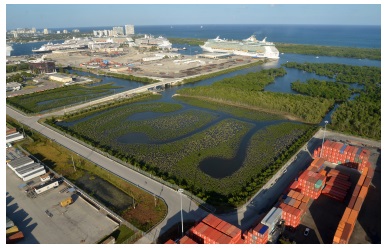
Port Everglades Mangrove Enhancement Area
Photo/Port Everglades
San Pedro Ports Unveil Strategies to Reduce Greenhouse Gases and Clean the Air
Deploying zero and near-zero emission trucks and cargo-handling equipment and expanding programs that reduce ship emissions are among the core strategies the ports of Los Angeles and Long Beach are proposing for the next version of the San Pedro Bay Ports Clean Air Action Plan (CAAP).
Proposals also focus on freight infrastructure investment, innovation and technology to improve supply chain efficiency, comprehensive energy planning, and increased advocacy for stricter emissions standards and government incentives to help pay for projects that advance testing and commercialization of zero and near-zero emission vehicles.Clean Vehicles, Equipment Technology and Fuels:
Freight Infrastructure Investment and Planning:
Energy Resource Planning:
CAAP 2017 improves upon the initial plan adopted in 2006 and updated in 2010 to reduce emissions from all port-related sources: ships, trucks, trains, cargo-handling and smaller harbor craft, such as tugboats. One original strategy, the Technology Advancement Program (TAP), was created to accelerate the development and demonstration of emission reduction technology.
To date, the ports have invested $15 million in 35 TAP projects. TAP successes include emission capture systems for ships at berth, hybrid-electric rubber tire gantry cranes, and drayage trucks and yard tractors fueled by liquefied natural gas, which are all now commercially available. The investment to date includes funding for zero and near-zero emission truck and yard tractor demonstration projects already in progress.
The port says that under the CAAP they have reduced DPM up to 85 percent, cut NOx in half, eliminated 97 percent of SOx, and lowered GHG an average of 12 percent, all while container volume has increased by 7 percent.
The discussion document is available at www.polb.com, www.portoflosangeles.org and www.cleanairactionplan.org.
Port Everglades Upland Mangrove Enhancement

Port Everglades Mangrove Enhancement Area
Photo/Port Everglades
Port Everglades is addressing a berthing capacity shortfall by developing new wetlands that support wildlife and ecological quality in the center of this urban, industrial seaport.
The Port Everglades Wetland Enhancement Project recently received a "Notification of Trending towards Success" from the Florida Department of Environmental Protection for successfully cultivating 16.5 acres of nursery-grown mangrove and native plants on property that was originally dry land intended for other uses. The notification is a critical component to the berth expansion effort because it releases 8.7 acres of an existing mangrove conservation easement adjacent to docks. The released acres will be excavated and the Southport Turning Notch expanded to make way for up to five cargo ship berths.
"We worked closely with port users, the environmental community, especially the South Florida Audubon Society, and the Florida Department of Environmental Protection to develop a plan for the new mangrove habitat that almost doubles the amount of mangrove conservation area in a more environmentally advantageous location within port property," said Port Everglades Chief Executive Steven Cernak, PPM®. "It is a win for Port Everglades and a win for the environment."
The project recently won IHS Maritime and Trade magazine's Dredging and Port Construction Innovation Award in the "Working/Engineering/Building with Nature Award" category.
The new Upland Mangrove Enhancement area is adjacent to a 40+ acre conservation easement and contains approximately 70,000 Florida-native, nursery-grown mangrove and wetland plants along with transition buffer plants. The enhancement restores and creates mangrove wetlands, which gives rise to habitat for aquatic species of fish and invertebrates, as well as nesting habitat for birds.
Extending the Southport Turning Notch will help relieve the berth congestion problem by lengthening the notch from approximately 900 feet to 2,400 feet. The project also includes up to six super post-Panamax cranes.
Mangroves not used for maintenance plantings were donated to the Broward County Parks and Recreation Division. More than 40 volunteers subsequently helped plant them in nearby restoration areas.
The Port Everglades Department's Seaport Engineering and Construction Division managed the project. Plans are underway to transfer the ownership of the land and entire conservation easement, almost 60 acres, to the state of Florida.